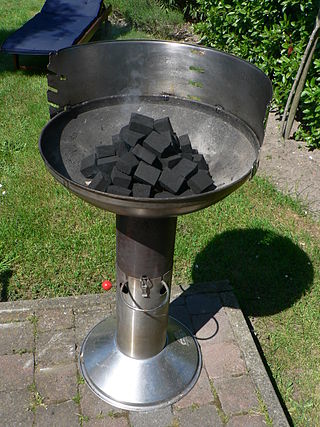
Roasting is a cooking method that uses dry heat where hot air covers the food, cooking it evenly on all sides with temperatures of at least 150 °C (300 °F) from an open flame, oven, or other heat source. Roasting can enhance the flavor through caramelization and Maillard browning on the surface of the food. Roasting uses indirect, diffused heat, and is suitable for slower cooking of meat in a larger, whole piece. Meats and most root and bulb vegetables can be roasted. Any piece of meat, especially red meat, that has been cooked in this fashion is called a roast. Meats and vegetables prepared in this way are described as "roasted", e.g., roasted chicken or roasted squash.

Shawarma is a popular Middle Eastern dish that originated in the Ottoman Empire, consisting of meat cut into thin slices, stacked in a cone-like shape, and roasted on a slowly-turning vertical rotisserie or spit. Traditionally made with lamb or mutton, it may also be made with chicken, turkey, beef, or veal. Thin slices are shaved off the cooked surface as it continuously rotates. Shawarma is a popular street food in the greater Middle East, including Egypt, Iraq, and the Levant.

Roast chicken is chicken prepared as food by roasting whether in a home kitchen, over a fire, or with a rotisserie. Generally, the chicken is roasted with its own fat and juices by circulating the meat during roasting, and therefore, are usually cooked exposed to fire or heat with some type of rotary grill so that the circulation of these fats and juices is as efficient as possible. Roast chicken is a dish that appears in a wide variety of cuisines worldwide.

Rotisserie, also known as spit-roasting, is a style of roasting where meat is skewered on a spit – a long solid rod used to hold food while it is being cooked over a fire in a fireplace or over a campfire, or roasted in an oven. This method is generally used for cooking large joints of meat or entire animals, such as pigs or turkeys. The rotation cooks the meat evenly in its own juices and allows easy access for continuous basting.

Chimichurri is an uncooked sauce used both as an ingredient in cooking and as a table condiment for grilled meat. Found in Argentinian and Uruguayan cuisines, the sauce comes in a green and red version. It is made of finely chopped parsley, minced garlic, olive oil, oregano and red wine vinegar or lemon juice. It is somewhat similar to Moroccan chermoula.

The cuisine of Hawaii incorporates five distinct styles of food, reflecting the diverse food history of settlement and immigration in the Hawaiian Islands.

Barbecue varies by the type of meat, sauce, rub, or other flavorings used, the point in barbecuing at which they are added, the role smoke plays, the equipment and fuel used, cooking temperature, and cooking time.

Poke is diced raw fish served either as an appetizer or a main course and is a popular dish in Hawaii. Traditional forms are aku and heʻe (octopus). Heʻe poke is sometimes called tako poke in places where the Hawaiian language is not spoken. Poke differs from other raw fish dishes in that it does not use citrus fruits as a curing agent.

Steven Raichlen is an American culinary writer, TV host, and novelist.

Beer can chicken is a barbecued chicken dish and method of indirect grilling using a partially-filled can of beer that is placed in the chicken's cavity prior to cooking. The chicken is then stood up on the can and its legs vertically, and slow-cooked over indirect heat, usually over a propane gas or charcoal grill. The process is meant to add moisture to the dish, and some believe that steam from the beer serves to steam the chicken from the inside and add flavor to the dish. Some people are avid proponents of the dish, while others have contended that the efficacy of using the beer is overrated, and that the science regarding beer can chicken is debatable. It has been suggested that the dish possibly originated in the U.S. state of Louisiana.

Basting is a cooking technique that involves cooking meat with either its own juices or some type of preparation such as a sauce or marinade. The meat is left to cook, then periodically coated with the juice.

Barbecue chicken consists of chicken parts or entire chickens that are barbecued, grilled or smoked. There are many global and regional preparation techniques and cooking styles. Barbecue chicken is often seasoned or coated in a spice rub, barbecue sauce, or both. Marinades are also used to tenderize the meat and add flavor. Rotisserie chicken has gained prominence and popularity in U.S. grocery markets. Barbecued chicken is one of the world's most popular barbecue dishes.

Inihaw, also known as sinugba or inasal, are various types of grilled or pit-roasted barbecue dishes from the Philippines. They are usually made from pork or chicken and are served on bamboo skewers or in small cubes with a soy sauce and vinegar-based dip. The term can also refer to any meat or seafood dish cooked and served in a similar way. Inihaw are commonly sold as street food and are eaten with white rice or rice cooked in coconut leaves (pusô). Inihaw is sometimes referred to as Filipino barbecue or (informally) Pinoy BBQ.

Rotisserie chicken is a chicken dish that is cooked on a rotisserie by using direct heat in which the chicken is placed next to the heat source.

Ernest Frank Morgado was a Portuguese-American businessman and community leader known for creating huli-huli chicken.


















